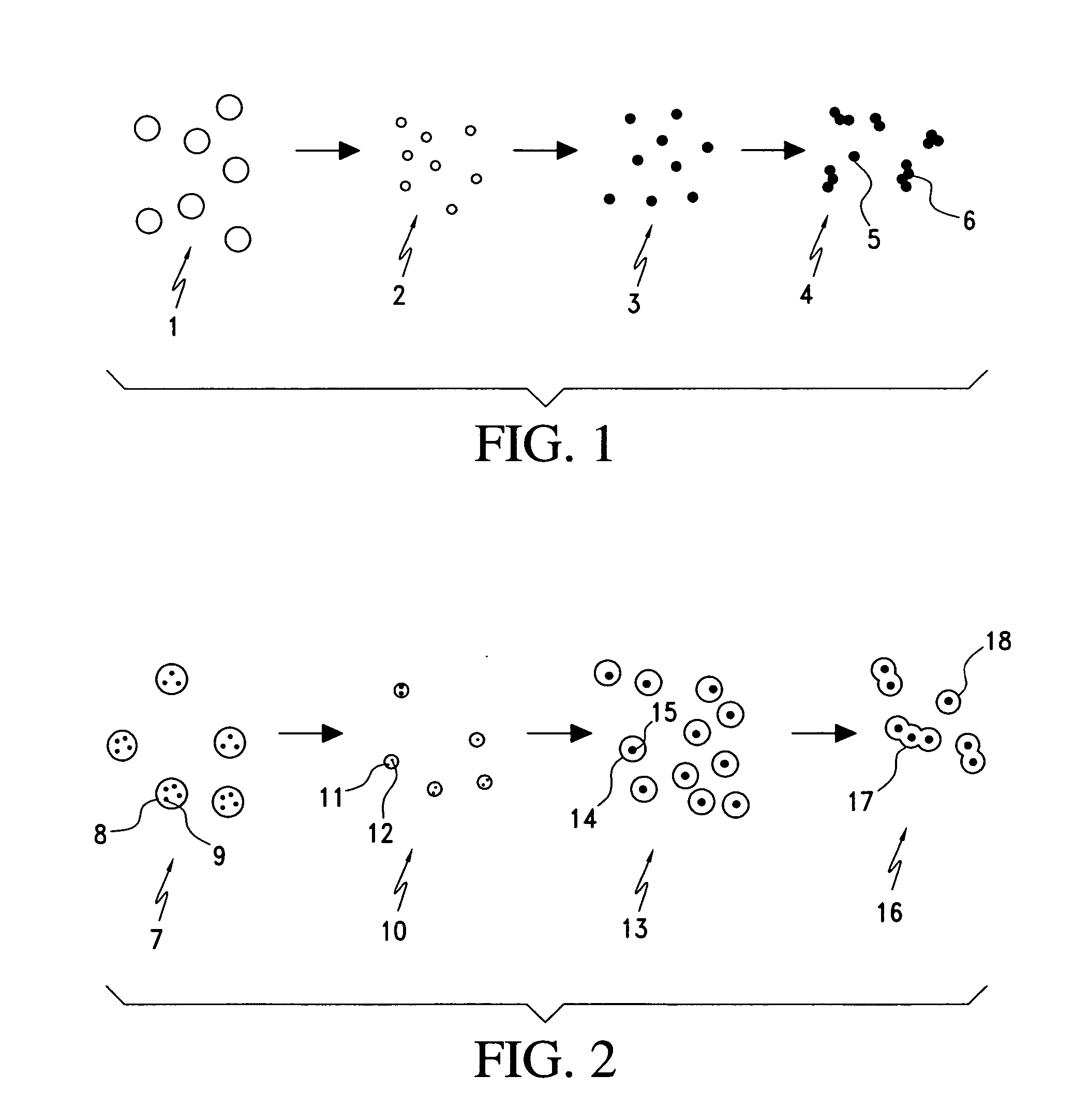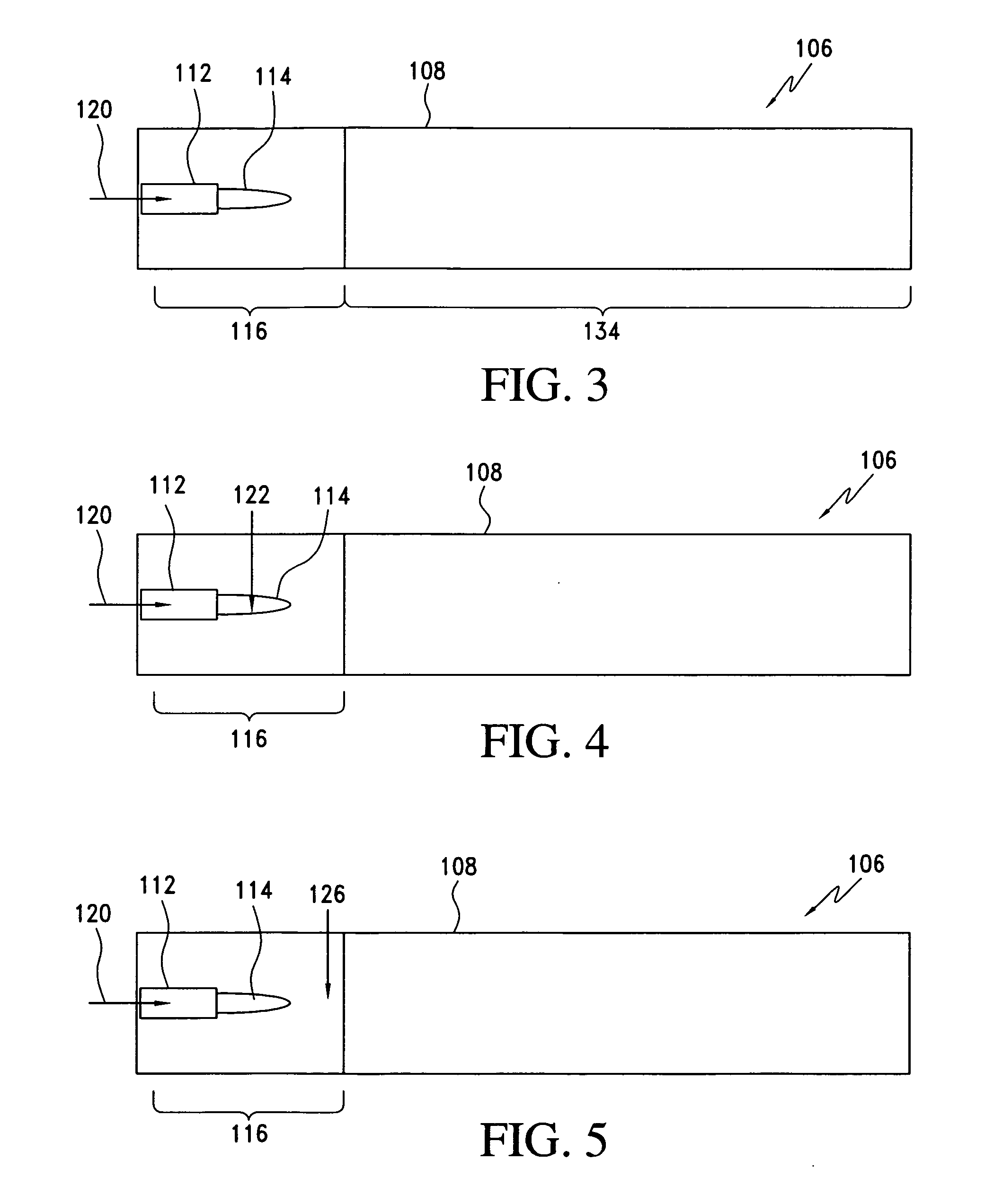Processes for forming nanoparticles in a flame spray system
a technology of flame spray and nanoparticles, which is applied in the direction of metal/metal-oxide/metal-hydroxide catalysts, magnetic bodies, silicates, etc., can solve the problems of significant range in size and other properties of nanoparticles
- Summary
- Abstract
- Description
- Claims
- Application Information
AI Technical Summary
Benefits of technology
Problems solved by technology
Method used
Image
Examples
example 1
Synthesis of Al2O3 Powders
[0180] Aluminum diisopropoxide ethylacetoacetate was dissolved in toluene, dispersed and introduced into the flame. Oxygen was used as a dispersion gas at 25 SLPM and the solution flow rate was 15 mL / min. The surface area of the Al2O3 was measured by N2 adsorption using the BET method and determined to be 75 m2 / g. Thermal stability of Al2O3 was determined by performing BET measurements after air calcination in the range from 900° C. to 1400° C. in dry air atmosphere. The Al2O3 samples produced using the method of this invention showed improved resistance to sintering at high temperatures compared to other, more conventional, materials. After calcinations at 1300° C., Al2O3 made by the process of this invention preserves ˜40 m2 / g of surface area. Even after calcinations at 1400° C. for 4 hr, Al2O3 made using the method of this invention has surface area of >12 m2 / g. The synthesized Al2O3 powders can be used for catalyst support.
example 2
Synthesis of Cerium Zirconium Oxide Powders
[0181] Cerium 2-ethylhexanoate and zirconium 2-ethylhexanoate mixed with toluene is used as the precursor solution for the synthesis of ceria zirconia powder. The metal weight percent of cerium and zirconium in the precursor solution varied from 3.9 to 4.3 and 2.8 to 2.5 respectively. The precursor flow rate and dispersing oxygen flow rate were 15 ml / min and 25 SLPM, respectively. Different furnaces were used to change the residence time and temperature profile in the reactor. The surface area of particles varied from 61 m2 / gm to 140 m2 / gm. The tunneling electron microscopy (TEM) and scanning electron microscopy (SEM) analysis shows that particles are non-agglomerated and crystalline in nature. The size of the primary particles varied from 10 to 30 nm. The x-ray diffraction (XRD) analysis confirmed the crystalline nature of the particle. The synthesized ceria zirconia powders can be used as a catalyst for environmental applications.
example 3
Synthesis of Aluminum Doped Zinc Oxide
[0182] Aluminum diisopropoxide ethylacetoacetate, zinc 2-ethylhexanoate mixed with toluene is used as the precursor solution for the synthesis of alumina doped zinc oxide powder. The metal weight percent of aluminum, and zinc in the precursor solution are 0.2 and 5.6 respectively. The precursor flow rate and dispersing oxygen flow rate were 15 m / min and 25 SLPM, respectively. The measured surface area of particles varied from 26 m2 / gm to 31 m2 / gm. The SEM and TEM analysis shows that particles are crystalline and partially agglomerated with the primary particle size varying from 40 to 150 nm. The quasi-elastic light scattering analysis using Malvern instrument shows that intensity average particle size is 178.3 nm lower temperature reactor was used, and the intensity average particle size of 157.8 nm when higher temperature reactor was used. The synthesized aluminum doped zinc oxide powders can be used as a transparent conductive oxide in electr...
PUM
| Property | Measurement | Unit |
|---|---|---|
| Temperature | aaaaa | aaaaa |
| Length | aaaaa | aaaaa |
| Fraction | aaaaa | aaaaa |
Abstract
Description
Claims
Application Information
 Login to View More
Login to View More - R&D
- Intellectual Property
- Life Sciences
- Materials
- Tech Scout
- Unparalleled Data Quality
- Higher Quality Content
- 60% Fewer Hallucinations
Browse by: Latest US Patents, China's latest patents, Technical Efficacy Thesaurus, Application Domain, Technology Topic, Popular Technical Reports.
© 2025 PatSnap. All rights reserved.Legal|Privacy policy|Modern Slavery Act Transparency Statement|Sitemap|About US| Contact US: help@patsnap.com



